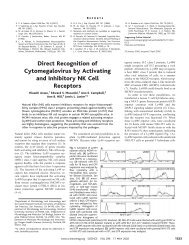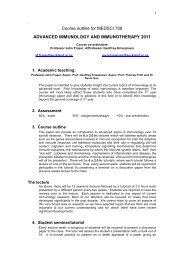Topic 2 lecture note..
Topic 2 lecture note..
Topic 2 lecture note..
Create successful ePaper yourself
Turn your PDF publications into a flip-book with our unique Google optimized e-Paper software.
L, M, X, D, and E integrins are major receptors of the immune system<br />
A subgroup of 2 integrins<br />
The four -subunits of this subgroup assemble with the integrin 2-subunit to generate<br />
the integrins L2 (LFA-1, CD11a/CD18), M2 (Mac-1, Mo-1, CR3, CD11b/CD18),<br />
X2 (p150,95, CR4, CD11c/CD18), and D2 (CD11d/CD18) (Springer, 1995). They<br />
are restricted to leukocytes, where L2 is expressed by most leukocytes, and M2 and<br />
X2 are on monocytes/macrophages, granulocytes, large granular lymphocytes, and a<br />
subpopulation of immature B cells. X2 is also present on some activated T cells.<br />
L2: L2 mediates the adhesion of leukocytes to the intercellular adhesion molecules<br />
ICAM-1, ICAM-2, and ICAM-3, which are inducibly or constitutively expressed on<br />
many cell types. It participates in leukocyte transendothelial migration, recirculation,<br />
homing, and localization to inflammatory sites. L2 plays a key role in antigenpresentation,<br />
T-cell costimulation, the cytotoxicity of T cells, delayed-type<br />
hypersensitivity, and endotoxin shock.<br />
Leukocytes from mice lacking L display defects in in vitro homotypic aggregation, in<br />
proliferation in mixed lymphocyte reactions, and in response to mitogen. In vivo, host-vsgraft<br />
reaction toward injected allogeneic cells is also reduced. Neutrophils and activated<br />
T lymphocytes are unable to cross endothelial cell monolayers in response to a<br />
chemokine gradient. The trafficking of lymphocytes to peripheral lymph nodes, and, to a<br />
lesser degree, to mesenteric lymph nodes and acute inflammatory sites is impaired.<br />
Mutant mice mounted normal cytotoxic T cell (CTL) responses against systemic LCMV<br />
and VSV infections, and showed normal ex vivo CTL function. However, they did not<br />
reject immunogenic tumors grafted into footpads, and did not demonstrate priming<br />
response against tumor-specific antigen. Thus L deficiency causes a selective defect in<br />
induction of peripheral immune responses, whereas responses to systemic infection are<br />
normal.<br />
M2 and X2: M2 interacts with an assortment of ligands including ICAM-1,<br />
iC3b, fibrinogen, serum factor X, and heparin, and may bind denatured proteins,<br />
deoxyoligonucleotides, elastase, high molecular weight kininogen, and carbohydrate -<br />
glucan structures. It interacts with the 3 rd Ig domain of ICAM-1, whereas L2 interacts<br />
with the 1 st Ig domain. When L2 and M2 are expressed at similar levels, the L2<br />
/ICAM-1 interaction dominates over the M2/ICAM-1 interaction.X2 binds to iC3b,<br />
fibrinogen, and ICAM-1. M2 and X2 mediate myeloid cell adhesion to<br />
endothelium, transmigration, chemotaxis, phagocytosis of opsonized particles, and<br />
respiratory burst. M2-deficient mice have significant reductions in the numbers of<br />
mast cells resident in the peritoneal cavity, peritoneal wall, and dorsal skin. Such mice<br />
exhibit significantly increased mortality to acute septic peritonitis, where host resistance<br />
depends on both mast cells and complement.<br />
D2: D2 binds preferentially to ICAM-3. The D subunit is more closely related to<br />
M and X than to L. D2 is expressed at moderate levels on myelomonocytic cell<br />
lines, and subsets of peripheral blood leukocytes. It is strongly expressed on tissue-





